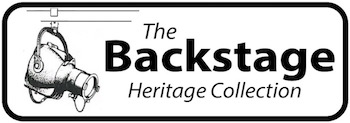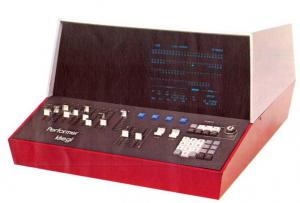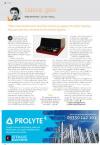
Performer (1979 - 1990s)
Kliegl

Kliegl Performer (1979)
The first portable memory lighting console, invented by Gordon Pearlman.
Based on the early TMS9900 microprocessor.
Performer I (1979): $24,000 list price when launched.
Video: Gordon Pearlman on the Performer
96 channels. Analog 0 to 10V output. No patch.
Performer II (Fall 1980)
Analog output. Up to 125 control channels
Evolved into the Pan Commander
Performer III (1987)
DMX output
Performer IV (1987?)
Repackaged / rebadged for Strand as Impact
The Kliegl Performer Story (edited by Rob Halliday, January 2020)
FROM GORDON PEARLMAN, 3 Jan 2020:
"I was hired by Kliegl to design a memory control console for Kliegl in 1976. Actually I was hired by Joel Rubin to be Western Regional Sales Manager (not including California and Nevada) but that was just a cover, John Kliegl did not see the need for a memory console.
I hired Steve Carlson who I had worked with during my short stay at Electronics Diversified (that’s another story). We set up shop in my extra bedroom. We were still picking wire-wrap wire out of the carpet when moved 10 year later.
Performance was large and modular desk with multiple TMS9900 CPUs from Texas Instruments. The layout and design was driven by sales and marketing and what was on the market including Preset Consoles.
Like everything else on the market it was not designed for touring. The rider on a show touring with Multi-Q called for a separately air conditioned space for the console.
When we started on Performer we had much more freedom to design a computer to do lighting rather than a computer pretending to be a conventional console. From the beginning Performer was a very secret project. The staff in NY knew little or nothing about it.
To design and tool a plastic or fiberglass enclosure was completely impossible for a project of this size. The breakthrough came when we found a company that was building a standard case that would meet our requirements. Now we had to fit all the stuff that had been in a very large console into a very small box.
I was often asked why a cassette tape. We needed something small and reliable. Original floppy disks (5 1/4”) were very large and not designed to be moved around.
Some details about Performer:
Texas Instruments TMS9900 microprocessor. This was a very early 16 bit CPU with the ability to “task switch” very quickly. Without rapid task switching it is impracticable to implement Subroutines or Interrupts both very important for real time process control.
We showed Performer first at USITT in Seattle. This was first time anyone except a few people at Kliegl had seen it. In those days consoles were built to order and manufacturers would show a single console at a show (normally right before it was delivered to a job). When the floor opened in Seattle the nine tables that had sat empty during load-in where topped with Performers that had been removed from their custom touring cases. To say the least they were a hit. Kliegl took multiple orders at the show.
Perfomer I - 1979 - 96 Channels - Analog 0-10V - no patch
Perfomer II - 1982 - 125 Channels - Analog Output
Performer III - 1982 - 125 Channels - K96 Output - Soft Patch
Performer IV - 1987 - 125 Channels - DMX-512 Output (when standard was introduced)
Strand Impact - 1989 - A Performer spinoff
Just to put these dates in perspective the original PC (no hard drive) was introduced in late 1981.
I assume you have heard the story of me taking a prat fall and sliding the touring case across the stage at USITT in Seattle then opening it up and demonstrating it still working.
Performer was a highest takes precedence console. I am a complete convert today: Last Action is the only way to go. But in those days the educational community did not agree. We didn’t have trained operators in those days. The board operator was normally an acting major who was forced to take tech courses. Kliegl Bros focus was on education theatre.
A couple of years after we introduced Performer, Colortran bought the same off-the-shelf enclosure - enough said.
Kliegl sold hundreds of Performers. It was the standard for touring both in theatre and rock and roll.
When moving lights came along it was adopted by Morpheus Lights as their console and then yet one more spinoff: The Morpheus Pan Commander.
Almost every rental company had multiple Performers in their inventory including:
- Four Star
- Bash
- Vanco
- Production Arts - starting with unit#2 on 11th July 1979
- Morpheus
- See Factor
- Bandit
- Theatre Projects
- Ryudensha Japan
- Cinema Services
- Flashlight
In regards to how it got to England:
Several weeks after the first showing in Seattle I took a demo unit to ABTT at the Round House. This is an important event: The first time a memory console was checked as baggage. My first stop was at Theatre Projects. I can’t really remember but I think we were showing it on TP’s stand. TP bought their first Performer on 25th October 1979.
The great part about that story is that NAB (National Association of Broadcasters) was in Dallas the day after ABTT. As Joel said as he pushed me out the door to go buy my ticket on the Concorde “You will never have an excuse like this again”.
Here are a couple of links you might like
http://www.klieglbros.com/catalogs/SpecSheets/performer/Perfomerc80brochure.htm
http://www.klieglbros.com/catalogs/SpecSheets/performer%20II/Perfomerspecs.htm
Understand this is the best of my recollection but I think it pretty close.
Regarding ownership:
When Kliegl started to go under and not pay their bills we took over manufacturer and all rights to Performer.
Regarding ending of Performer:
We had really beaten that horse till it was barely alive. Kliegl was gone and PCs had become fast enough that it was now possible the refresh all the channels and still maintain an operating system.
The thing that everyone forgets about these early systems is that there was no Operating System and no high level language. If you wanted to get data off the disk you didn’t write:
ReadFile (“fileName“). You wrote 20 pages of code to monitor the disk rotation and picked off one bit at a time. One line of code = one machine instruction.
Probably more important we had designed a whole line of architectural controls for Lightolier (now Philips) on a royalty basis."
FROM STEVE TERRY, 3 Jan 2020:
"The Performer was the outgrowth of the TI 99000-based Performance--which was a Kliegl response to the Century Multi-Q from David Cunningham. Performance was physically huge and cost in the neighborhood of $40,000. It was the first implementation of a 16-bit on-chip microprocessor in a lighting control system. Production Arts bought one of them to run a big animated Coca-Cola sign for trade show applications. It needed a roadbox the size of a small house. Performer used the same processor.
Performer was dreamed up by Gordon and Steve Carlson. The first implementation of the hardware was executed by Precision Controls, Kliegl's electronics subcontractor. It was fairly unreliable, but still sold a lot. Production Arts ordered five of them at $15,000 each. These Performer I units can be identified by the red top on the enclosure. They were the first memory consoles in history suited to rental use. There was no FedEx at the time, but the frequent replacements could be shipped by Greyhound bus.
About 18 months later, the Performer II/III was released. Steve Carlson did the PCB layout, which eliminated the very unreliable mother/daughter two board arrangement of Performer 1. Performer II/III has a black top cover. Production Arts bought about 15 of these units--they rented for $500 the first week and $250 per week thereafter. The gold rush was on! The PA-modified units are the ones that found their way into TP's West End Stock. Modifications included:
1. A static memory board backed up by a super-cap to replace the original dynamic memory which was unreliably backed up by NiCad D cells.
2. A DMX512 output board. Original Performer II had only 125 analog outputs. Performer III spoke K-96 protocol at about 85 kb/s.
I recall that TP sent someone to inspect the consoles before taking delivery--the name Jenny Cane comes to mind. By the time TP wanted them, PA was moving on to Mini-Light Palette and ETC Idea and Microvision for the less expensive units. We were happy that TP wanted the Performer II's! I don’t know if all TP’s units were second hand from PA, but I think at least four were.
Mini Light Palette was in demand because designers wanted a tracking console that shared syntax with Light Palette."
FROM HOWARD EATON, 3 Jan 2020:
"I think Roger Straker who was running Theatre Projects might have found it - he was trying to drag TP into multi-core, high-density dimming.
The Performer ran Cats, it ran the Torvill and Dean ice shows which Andy Bridge lit - for that Andy had a 96-way Avo and a Performer dioded together so he could either busk the show on the Avo or record it on the Performer; Theatre Projects built a box bristling with diode connections so it took in both desks then outputted to the dimmers.
On Time we did something similar: we took the outputs of ten Avo faders and connected them into the Performer, so the Avo could drive the Perfomer’s submasters to chase memory presets for the first part of the show, which was a big rock gig. We had to drill a hole in TP’s brand-new Performer to do that...
The Performer did have chases - gold pages, certain pages of memory numbers that were automatically looped. Nothing else did that sort of thing for that size, 125 outputs.
Cats on Broadway used two of them because the channel count got too high; Production Arts sub-hired them to Four Star, connected the go buttons together. That sub-hire went on forever - no-one thought the show would run! The Cats tour would have been on Performers. So was the Superstar tour before Cats - Zenith had to buy the desk, first truss, multi-core, high-density dimming. Alan Jacobi, Mike Odam as the touring chief and board-op.
Performer had one keyboard and a channel button and a memory button. Once you recorded a memory you had to remember to put the keyboard back to channel mode. By contrast Galaxy of the time had two keypads. No-one is bothered about this now.
Early desks used cassettes for storage, later ones disks. On Torvill and Dean Olly Olsen went in on the morning of the opening night to do the notes from the night before, rang me saying you really need to come in you really do I think I’ve wiped the show. Went through and all he had on any of the discs were the notes, not the show. Phoned Andy, who came in and sat down and lit the show from scratch that morning. From that day on Andy always kept a copy of the discs from last night.
There was a small ‘cue library’ button, which meant go to the pub...
They hung around - Cats on Broadway 1982 still there into the 1990s, Cats London 1991 still on the Performer up to the mid-90s.
Kliegl - Joel Rubin. They were all competing for installation jobs. Kliegl bought people’s technology because everyone was competing for equipment to sell to people. Gordon Pearlman, the great genius of them all, and one of the nicest gentlemen in the industry. He understood what it needed to do - he actually knew what lighting desks needed to do, he was a theatrical man.
In its time Performer was absolutely revolutionary, and a break from all that Strand installation stuff that you couldn’t lift. It was the start of the move to the kind of thing rock-and-roll had been doing, bringing in everything from a show, everything portable."
Cue magazine (see below) reports that in 1980, a Performer was available to hire from Theatre Projects Ltd for £400 per week (around £1665 per week in 2018 prices)
A wonderful interview with Gordon Pearlman can be found in Robert Bell's 'Let There Be Light'.
Related Venues:
Related Shows
See also:
Documents

Advert - Kliegl Performer (Theatre Design & Technology, Spring 1979) (April 1979)
Click on thumbnail to enlarge
[191kb JPEG]

Advert: Performer II (Theatre Design and Technology, 1980) (December 1980)
Click on thumbnail to enlarge
[143kb JPEG]
Catalogue & Journal Entries for Performer in the Backstage Heritage Collection
Back to Control - Memory (Kliegl)
4395



